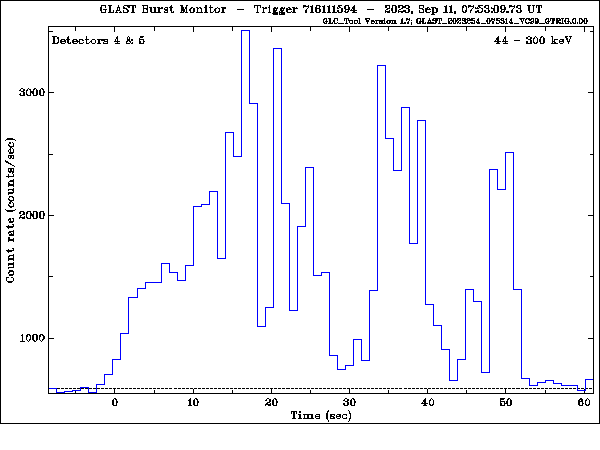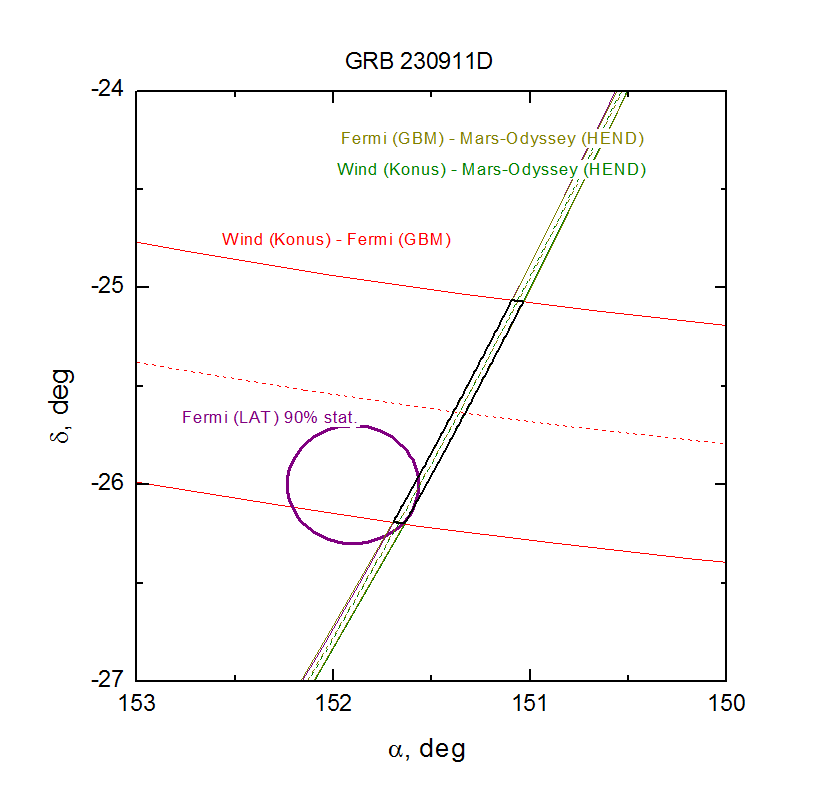(All information courtesy of the instrument teams.)
![]() Previous IAU Circulars
Previous IAU Circulars
TITLE: GCN/FERMI NOTICE
NOTICE_DATE: Mon 11 Sep 23 07:53:29 UT
NOTICE_TYPE: Fermi-GBM Flight Position
RECORD_NUM: 70
TRIGGER_NUM: 716111594
GRB_RA: 13.250d {+00h 53m 00s} (J2000),
13.500d {+00h 54m 00s} (current),
12.720d {+00h 50m 53s} (1950)
GRB_DEC: -60.250d {-60d 15' 00"} (J2000),
-60.122d {-60d 07' 17"} (current),
-60.521d {-60d 31' 16"} (1950)
GRB_ERROR: 3.68 [deg radius, statistical plus systematic]
GRB_INTEN: 2424 [cnts/sec]
DATA_SIGNIF: 87.00 [sigma]
INTEG_TIME: 4.096 [sec]
GRB_DATE: 20198 TJD; 254 DOY; 23/09/11
GRB_TIME: 28389.73 SOD {07:53:09.73} UT
GRB_PHI: 345.00 [deg]
GRB_THETA: 160.00 [deg]
DATA_TIME_SCALE: 4.0960 [sec]
HARD_RATIO: 0.52
LOC_ALGORITHM: 3 (version number of)
MOST_LIKELY: 95% GRB
2nd_MOST_LIKELY: 4% Generic Transient
DETECTORS: 0,0,0, 0,1,1, 0,0,0, 0,0,0, 0,0,
SUN_POSTN: 169.28d {+11h 17m 06s} +4.61d {+04d 36' 39"}
SUN_DIST: 121.50 [deg] Sun_angle= 10.4 [hr] (West of Sun)
MOON_POSTN: 131.44d {+08h 45m 46s} +23.27d {+23d 16' 15"}
MOON_DIST: 123.85 [deg]
MOON_ILLUM: 12 [%]
GAL_COORDS: 302.58,-56.88 [deg] galactic lon,lat of the burst (or transient)
ECL_COORDS: 333.48,-57.33 [deg] ecliptic lon,lat of the burst (or transient)
LC_URL: http://heasarc.gsfc.nasa.gov/FTP/fermi/data/gbm/triggers/2023/bn230911329/quicklook/glg_lc_medres34_bn230911329.gif
COMMENTS: Fermi-GBM Flight-calculated Coordinates.
COMMENTS: This trigger occurred at longitude,latitude = 39.58,-0.08 [deg].
COMMENTS: The LC_URL file will not be created until ~15 min after the trigger.
TITLE: GCN/FERMI NOTICE
NOTICE_DATE: Mon 11 Sep 23 07:53:13 UT
NOTICE_TYPE: Fermi-GBM Flight Position
RECORD_NUM: 48
TRIGGER_NUM: 716111594
GRB_RA: 352.567d {+23h 30m 16s} (J2000),
352.912d {+23h 31m 39s} (current),
351.830d {+23h 27m 19s} (1950)
GRB_DEC: -68.450d {-68d 27' 00"} (J2000),
-68.319d {-68d 19' 08"} (current),
-68.726d {-68d 43' 32"} (1950)
GRB_ERROR: 9.82 [deg radius, statistical plus systematic]
GRB_INTEN: 342 [cnts/sec]
DATA_SIGNIF: 8.10 [sigma]
INTEG_TIME: 1.024 [sec]
GRB_DATE: 20198 TJD; 254 DOY; 23/09/11
GRB_TIME: 28389.73 SOD {07:53:09.73} UT
GRB_PHI: 12.00 [deg]
GRB_THETA: 155.00 [deg]
DATA_TIME_SCALE: 1.0240 [sec]
HARD_RATIO: 0.84
LOC_ALGORITHM: 3 (version number of)
MOST_LIKELY: 98% GRB
2nd_MOST_LIKELY: 1% Generic Transient
DETECTORS: 0,0,0, 0,1,1, 0,0,0, 0,0,0, 0,0,
SUN_POSTN: 169.28d {+11h 17m 06s} +4.61d {+04d 36' 39"}
SUN_DIST: 116.24 [deg] Sun_angle= 11.8 [hr] (West of Sun)
MOON_POSTN: 131.44d {+08h 45m 45s} +23.27d {+23d 16' 17"}
MOON_DIST: 128.42 [deg]
MOON_ILLUM: 12 [%]
GAL_COORDS: 313.69,-46.95 [deg] galactic lon,lat of the burst (or transient)
ECL_COORDS: 311.37,-56.56 [deg] ecliptic lon,lat of the burst (or transient)
LC_URL: http://heasarc.gsfc.nasa.gov/FTP/fermi/data/gbm/triggers/2023/bn230911329/quicklook/glg_lc_medres34_bn230911329.gif
COMMENTS: Fermi-GBM Flight-calculated Coordinates.
COMMENTS: This trigger occurred at longitude,latitude = 39.58,-0.08 [deg].
COMMENTS: The LC_URL file will not be created until ~15 min after the trigger.
TITLE: GCN/FERMI NOTICE
NOTICE_DATE: Mon 11 Sep 23 07:53:21 UT
NOTICE_TYPE: Fermi-GBM Flight Position
RECORD_NUM: 59
TRIGGER_NUM: 716111594
GRB_RA: 12.800d {+00h 51m 12s} (J2000),
13.052d {+00h 52m 12s} (current),
12.267d {+00h 49m 04s} (1950)
GRB_DEC: -60.500d {-60d 30' 00"} (J2000),
-60.371d {-60d 22' 16"} (current),
-60.772d {-60d 46' 17"} (1950)
GRB_ERROR: 3.92 [deg radius, statistical plus systematic]
GRB_INTEN: 1586 [cnts/sec]
DATA_SIGNIF: 57.50 [sigma]
INTEG_TIME: 4.096 [sec]
GRB_DATE: 20198 TJD; 254 DOY; 23/09/11
GRB_TIME: 28389.73 SOD {07:53:09.73} UT
GRB_PHI: 345.00 [deg]
GRB_THETA: 160.00 [deg]
DATA_TIME_SCALE: 4.0960 [sec]
HARD_RATIO: 0.66
LOC_ALGORITHM: 3 (version number of)
MOST_LIKELY: 96% GRB
2nd_MOST_LIKELY: 3% Generic Transient
DETECTORS: 0,0,0, 0,1,1, 0,0,0, 0,0,0, 0,0,
SUN_POSTN: 169.28d {+11h 17m 06s} +4.61d {+04d 36' 39"}
SUN_DIST: 121.39 [deg] Sun_angle= 10.4 [hr] (West of Sun)
MOON_POSTN: 131.44d {+08h 45m 45s} +23.27d {+23d 16' 16"}
MOON_DIST: 124.01 [deg]
MOON_ILLUM: 12 [%]
GAL_COORDS: 302.99,-56.63 [deg] galactic lon,lat of the burst (or transient)
ECL_COORDS: 332.86,-57.34 [deg] ecliptic lon,lat of the burst (or transient)
LC_URL: http://heasarc.gsfc.nasa.gov/FTP/fermi/data/gbm/triggers/2023/bn230911329/quicklook/glg_lc_medres34_bn230911329.gif
COMMENTS: Fermi-GBM Flight-calculated Coordinates.
COMMENTS: This trigger occurred at longitude,latitude = 39.58,-0.08 [deg].
COMMENTS: The LC_URL file will not be created until ~15 min after the trigger.
TITLE: GCN/FERMI NOTICE
NOTICE_DATE: Mon 11 Sep 23 07:53:28 UT
NOTICE_TYPE: Fermi-GBM Ground Position
RECORD_NUM: 58
TRIGGER_NUM: 716111594
GRB_RA: 153.610d {+10h 14m 26s} (J2000),
153.889d {+10h 15m 33s} (current),
153.021d {+10h 12m 05s} (1950)
GRB_DEC: -22.540d {-22d 32' 23"} (J2000),
-22.658d {-22d 39' 29"} (current),
-22.291d {-22d 17' 27"} (1950)
GRB_ERROR: 3.41 [deg radius, statistical only]
DATA_SIGNIF: 36.70 [sigma]
DATA_INTERVAL: 2.048 [sec]
GRB_DATE: 20198 TJD; 254 DOY; 23/09/11
GRB_TIME: 28389.73 SOD {07:53:09.73} UT
GRB_PHI: 348.00 [deg]
GRB_THETA: 69.00 [deg]
E_RANGE: 44.032 - 279.965 [keV]
LOC_ALGORITHM: 4173 (Gnd S/W Version number)
SUN_POSTN: 169.28d {+11h 17m 06s} +4.61d {+04d 36' 39"}
SUN_DIST: 31.14 [deg] Sun_angle= 1.0 [hr] (West of Sun)
MOON_POSTN: 131.44d {+08h 45m 46s} +23.27d {+23d 16' 15"}
MOON_DIST: 50.85 [deg]
MOON_ILLUM: 12 [%]
GAL_COORDS: 261.72, 27.50 [deg] galactic lon,lat of the burst (or transient)
ECL_COORDS: 164.84,-31.00 [deg] ecliptic lon,lat of the burst (or transient)
LC_URL: http://heasarc.gsfc.nasa.gov/FTP/fermi/data/gbm/triggers/2023/bn230911329/quicklook/glg_lc_medres34_bn230911329.gif
POS_MAP_URL: http://gcn.gsfc.nasa.gov/notices_f/gbm_gnd_loc_map_716111594.fits
COMMENTS: Fermi-GBM Ground-calculated Coordinates.
COMMENTS: This Notice was ground-generated -- not flight-generated.
COMMENTS: The LC_URL file will not be created/available until ~15 min after the trigger.
COMMENTS: The POS_MAP_URL file will not be created/available until ~1.5 min after the notice.
TITLE: GCN/FERMI NOTICE
NOTICE_DATE: Mon 11 Sep 23 07:53:36 UT
NOTICE_TYPE: Fermi-GBM Flight Position
RECORD_NUM: 73
TRIGGER_NUM: 716111594
GRB_RA: 13.550d {+00h 54m 12s} (J2000),
13.799d {+00h 55m 12s} (current),
13.021d {+00h 52m 05s} (1950)
GRB_DEC: -60.100d {-60d 06' 00"} (J2000),
-59.972d {-59d 58' 18"} (current),
-60.371d {-60d 22' 14"} (1950)
GRB_ERROR: 3.50 [deg radius, statistical plus systematic]
GRB_INTEN: 3968 [cnts/sec]
DATA_SIGNIF: 136.40 [sigma]
INTEG_TIME: 4.096 [sec]
GRB_DATE: 20198 TJD; 254 DOY; 23/09/11
GRB_TIME: 28389.73 SOD {07:53:09.73} UT
GRB_PHI: 345.00 [deg]
GRB_THETA: 160.00 [deg]
DATA_TIME_SCALE: 4.0960 [sec]
HARD_RATIO: 0.43
LOC_ALGORITHM: 3 (version number of)
MOST_LIKELY: 95% GRB
2nd_MOST_LIKELY: 4% Generic Transient
DETECTORS: 0,0,0, 0,1,1, 0,0,0, 0,0,0, 0,0,
SUN_POSTN: 169.28d {+11h 17m 06s} +4.61d {+04d 36' 39"}
SUN_DIST: 121.56 [deg] Sun_angle= 10.4 [hr] (West of Sun)
MOON_POSTN: 131.44d {+08h 45m 46s} +23.27d {+23d 16' 14"}
MOON_DIST: 123.73 [deg]
MOON_ILLUM: 12 [%]
GAL_COORDS: 302.30,-57.02 [deg] galactic lon,lat of the burst (or transient)
ECL_COORDS: 333.87,-57.33 [deg] ecliptic lon,lat of the burst (or transient)
LC_URL: http://heasarc.gsfc.nasa.gov/FTP/fermi/data/gbm/triggers/2023/bn230911329/quicklook/glg_lc_medres34_bn230911329.gif
COMMENTS: Fermi-GBM Flight-calculated Coordinates.
COMMENTS: This trigger occurred at longitude,latitude = 39.58,-0.08 [deg].
COMMENTS: The LC_URL file will not be created until ~15 min after the trigger.
TITLE: GCN/FERMI NOTICE
NOTICE_DATE: Mon 11 Sep 23 08:23:36 UT
NOTICE_TYPE: Fermi-GBM Final Position
RECORD_NUM: 0
TRIGGER_NUM: 716111594
GRB_RA: 154.850d {+10h 19m 24s} (J2000),
155.132d {+10h 20m 32s} (current),
154.255d {+10h 17m 01s} (1950)
GRB_DEC: -20.920d {-20d 55' 11"} (J2000),
-21.039d {-21d 02' 21"} (current),
-20.669d {-20d 40' 06"} (1950)
GRB_ERROR: 1.00 [deg radius, statistical only]
GRB_DATE: 20198 TJD; 254 DOY; 23/09/11
GRB_TIME: 28389.73 SOD {07:53:09.73} UT
GRB_PHI: 348.58 [deg]
GRB_THETA: 67.16 [deg]
E_RANGE: 50.000 - 300.000 [keV]
LOC_ALGORITHM: 415 (Gnd S/W Version number)
SUN_POSTN: 169.29d {+11h 17m 11s} +4.60d {+04d 36' 11"}
SUN_DIST: 29.16 [deg] Sun_angle= 0.9 [hr] (West of Sun)
MOON_POSTN: 131.70d {+08h 46m 48s} +23.20d {+23d 12' 02"}
MOON_DIST: 49.78 [deg]
MOON_ILLUM: 12 [%]
GAL_COORDS: 261.57, 29.48 [deg] galactic lon,lat of the burst (or transient)
ECL_COORDS: 165.28,-29.05 [deg] ecliptic lon,lat of the burst (or transient)
LC_URL: http://heasarc.gsfc.nasa.gov/FTP/fermi/data/gbm/triggers/2023/bn230911329/quicklook/glg_lc_medres34_bn230911329.gif
LOC_URL: http://heasarc.gsfc.nasa.gov/FTP/fermi/data/gbm/triggers/2023/bn230911329/quicklook/glg_locplot_all_bn230911329.png
COMMENTS: Fermi-GBM Final Position.
COMMENTS: This Notice was ground-generated -- not flight-generated.
COMMENTS: The LC_URL file should be available by the time this FINAL notice is produced.
COMMENTS: This notice has human-in-the-loop processing.

RA(2000.0) = 148.9+/-0.2 deg Decl.(2000.0) = -23.4+/-0.7 degWe estimate an additional systematic error of 1 deg.
TITLE: GCN/FERMI NOTICE
NOTICE_DATE: Mon 11 Sep 23 15:00:25 UT
NOTICE_TYPE: Fermi-LAT Offline Position
TRIGGER_NUM: 230911329
GRB_RA: 151.900d {+10h 07m 36s} (J2000),
152.173d {+10h 08m 42s} (current),
151.324d {+10h 05m 18s} (1950)
GRB_DEC: -25.970d {-25d 58' 11"} (J2000),
-26.086d {-26d 05' 10"} (current),
-25.725d {-25d 43' 29"} (1950)
GRB_ERROR: 14.39 [arcmin radius, 90% containment, statistical only]
GRB_DATE: 20198 TJD; 254 DOY; 23/09/11
GRB_TIME: 28389.72 SOD {07:53:09.72} UT
TRIGGER_ID: 0x0
MISC: 0x40000000
SUN_POSTN: 169.54d {+11h 18m 10s} +4.50d {+04d 29' 53"}
SUN_DIST: 34.91 [deg] Sun_angle= 1.2 [hr] (West of Sun)
MOON_POSTN: 135.07d {+09h 00m 18s} +22.24d {+22d 14' 15"}
MOON_DIST: 51.08 [deg]
MOON_ILLUM: 10 [%]
GAL_COORDS: 262.81, 23.86 [deg] galactic lon,lat of the burst (or transient)
ECL_COORDS: 164.88,-34.76 [deg] ecliptic lon,lat of the burst (or transient)
COMMENTS: Fermi LAT Offline position.
COMMENTS: This Notice was ground-generated -- not flight-generated.
COMMENTS: It is the result of human-in-the-loop processing.
COMMENTS: This is a human generated position of a LAT ground detection.
COMMENTS: This source corresponds to GBM trigger.
--------------------------------------------- RA(2000), deg Dec(2000), deg --------------------------------------------- Center: 151.360 (10h 05m 26s) -25.633 (-25d 38' 00") Corners: 151.696 (10h 06m 47s) -26.192 (-26d 11' 31") 151.638 (10h 06m 33s) -26.200 (-26d 12' 01") 151.036 (10h 04m 09s) -25.072 (-25d 04' 18") 151.093 (10h 04m 22s) -25.064 (-25d 03' 51") ---------------------------------------------The error box area is 226 sq. arcmin, and its maximum dimension is 1.3 deg (the minimum one is 3 arcmin). The Sun distance was 35 deg.
